Mana Neyestani (b. 1973) is an Iranian cartoonist, best known for his single panel political cartoons on Radio Zamaneh and in the short-lived newspaper Zan. In 2010, he received the Cartoonists Rights Network International’s Award for Courage in Editorial Cartooning. 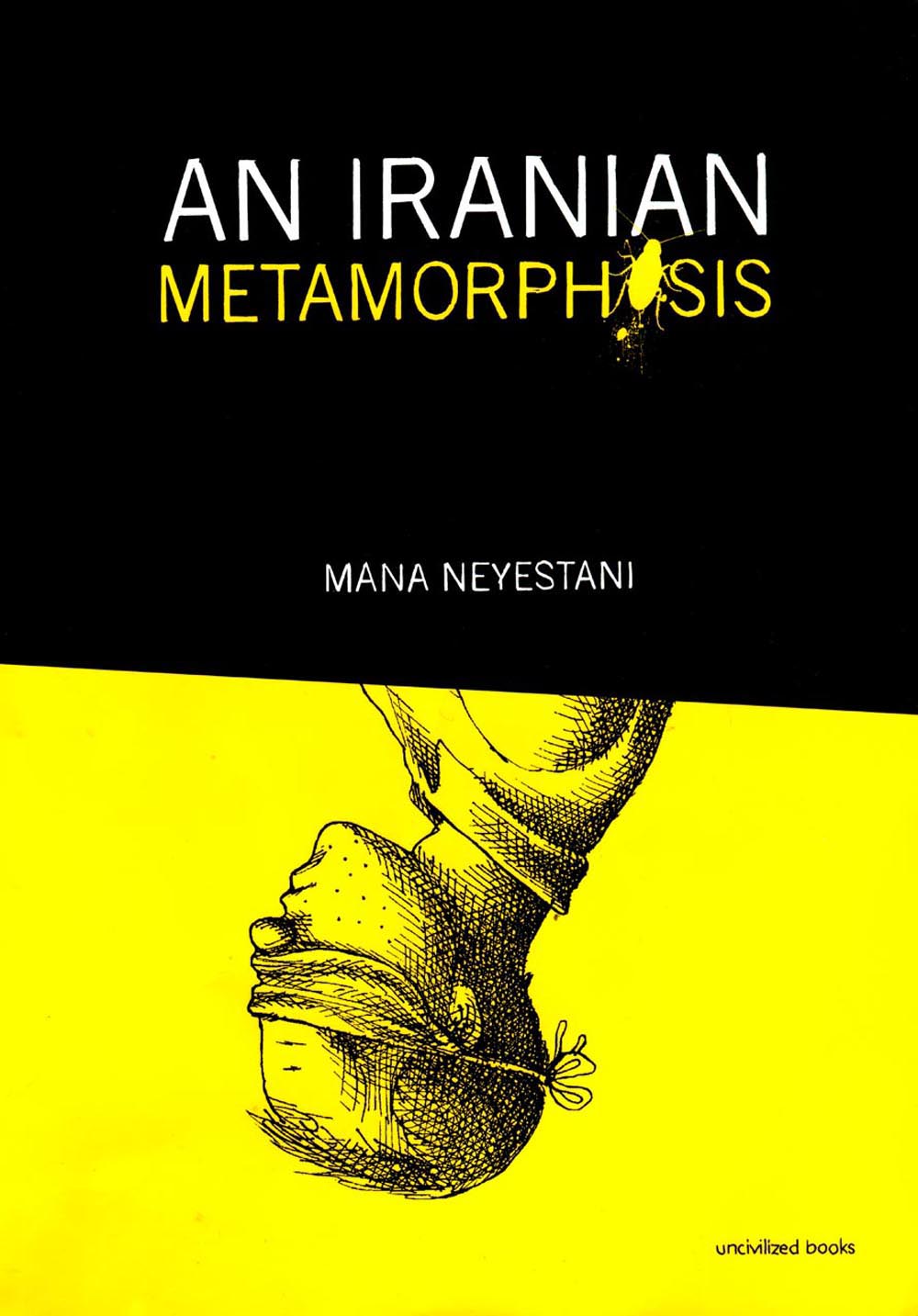 His graphic novel, An Iranian Metamorphosis (2014), recounts his Kafka-esque living-nightmare when one of his cartoons provoked a furious backlash from Azeris, an ethnic minority in Iran. Demonstrations began at universities and spread to many Azeri-populated cities across the country. The government shut down the newspaper—which they could easily do because they owned the newspaper—and Neyestani and the newspaper’s editor-in-chief were thrown into prison. Riots erupted throughout Iran and resulted in over 300 arrests, four deaths, and undocumented amounts of property damage. And all because of this cartoon.
His graphic novel, An Iranian Metamorphosis (2014), recounts his Kafka-esque living-nightmare when one of his cartoons provoked a furious backlash from Azeris, an ethnic minority in Iran. Demonstrations began at universities and spread to many Azeri-populated cities across the country. The government shut down the newspaper—which they could easily do because they owned the newspaper—and Neyestani and the newspaper’s editor-in-chief were thrown into prison. Riots erupted throughout Iran and resulted in over 300 arrests, four deaths, and undocumented amounts of property damage. And all because of this cartoon.
Or maybe not.
Neyestani—a non-Azeri—insists that the symbolism of the cockroach was all just a big misunderstanding. He never meant any offense and so the Azeris had no cause to react the way they did. Yet, one could argue that regardless of Neyestani’s intention, the semiotics of the cartoon speak for themselves. And even still, one could argue that the Azeris’ reaction had more to do with an underlying societal attitude that had reached a boiling point. This cartoon just sparked the reaction. The question that lingers even after reading the book is about the use of symbolism in the cartoon and who has the final say—the creator or the readers? Who is in charge here? Who says what the meaning is, and which is more valid—artistic intention or public perception?
***
The Book
I have to say that I was thrilled to find this book. I am an avid reader of graphic novels and I pay particular attention to those that take place in the Middle East. Persepolis, Zahra’s Paradise and A Game for Swallows number among my favorites. As volatile as the political landscape is across the Middle East and as much as I do not trust that mainstream news sources are revealing the whole story, I find solace in the first person graphic narrative.
The book itself has a great hand-held quality. If you don’t know what I mean by that, get yourself to a bookstore and just pick it up. Flip through the pages, back and forth. It feels good.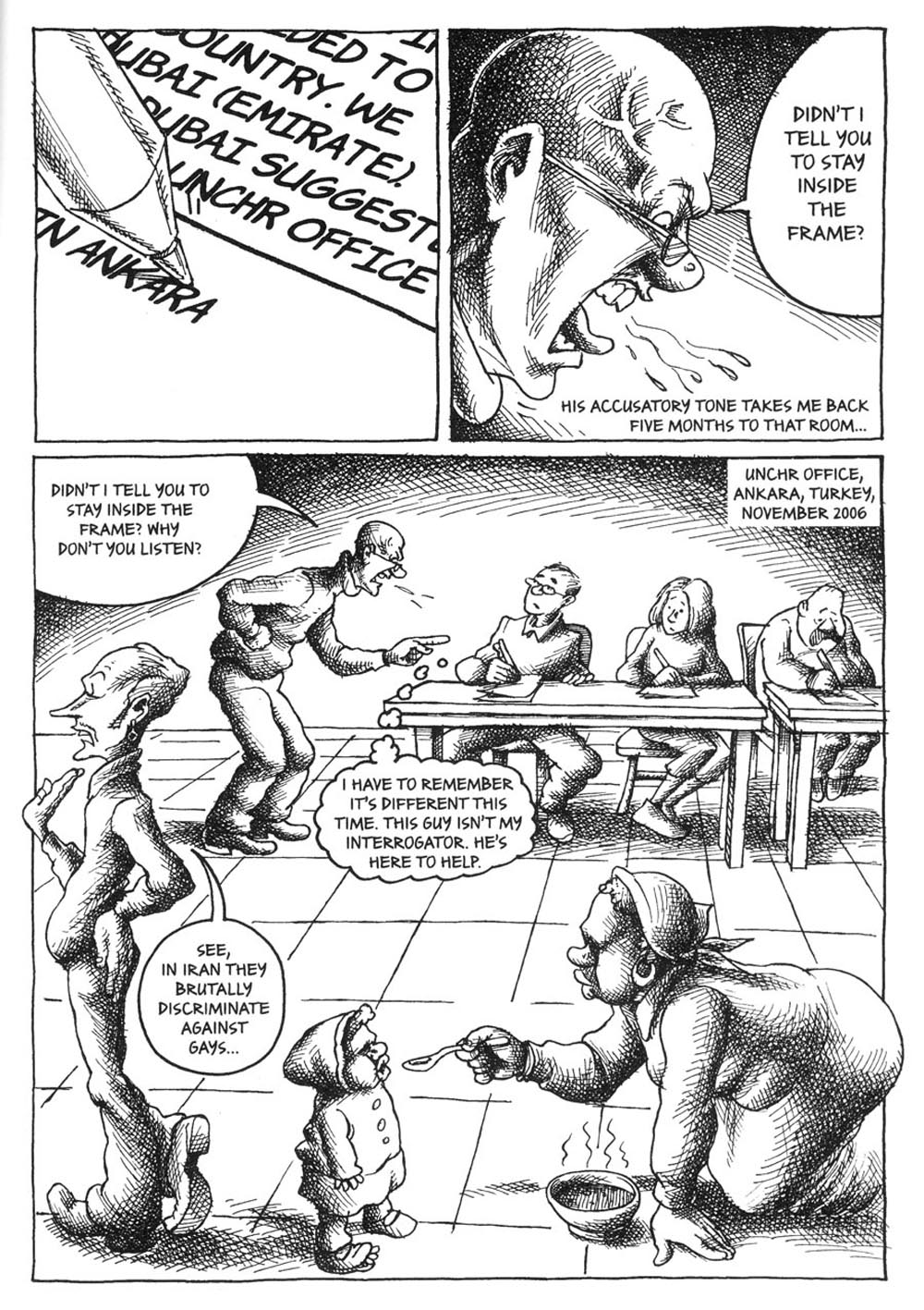 It’s the kind of book that feels even better once you’ve read it and then lent it out to several friends who miraculously return it to you in one piece. The book has resilience. It’s got tough binding and a flexible form. And it’s exactly the scale it should be for the drawings inside.
It’s the kind of book that feels even better once you’ve read it and then lent it out to several friends who miraculously return it to you in one piece. The book has resilience. It’s got tough binding and a flexible form. And it’s exactly the scale it should be for the drawings inside.
The drawings are beautiful. And though this is a ridiculous scenario, they look like Joe Sacco tried to imitate a Beetle Bailey comic strip while capturing the post-apocalyptic energy of the Transmetropolitan comic books. It’s different to say the least. The tone of the book is aggressively intense, but it’s minimalist, too. Neyestani’s pen and ink cross-hatching is confidently loose and has little if any digital treatment. It feels raw and direct like he drew the whole book in one sitting and then passed it over to you to read. The rhythms of the layouts and splash pages hum along to the tempo of the story. Neyestani is a political cartoonist who totally gets long-form comics.
I really, really liked this book. I set out reading it and wanting it to win. But along the way, I realized that the story had problems that were difficult to overlook.
***
The Controversy
In the first chapter of An Iranian Metamorphosis, his tale of the infamous “Cockroach Cartoon Controversy,” Neyestani describes the day he casually and almost out of boredom created a simple cartoon about a boy and a bug. It was called, “How to Fight a Cockroach.” Below is a translation of the original Farsi text that accompanied the drawing. It is worth noting that the translation was not made available in the book.
First method: dialogue
Some people believe that one should not resort to violence as an initial step, because that will just take all the fun out of the process. So we must first try to come to the table like civilized people and have a dialogue with the cockroaches.
But the problem is that a cockroach cannot understand human language [i.e., reasoned argument]. And cockroach grammar is so difficult–nobody has yet discovered which of their verbs end in “ing”–that 80% of the cockroaches themselves do not know it and prefer to speak in other languages. When even the cockroaches do not understand their own language, how could you possibly understand it?! This is precisely why negotiations hit a dead-end and the sweet methodology of violence becomes a necessity!
The illustration shows a young boy following the advice of the text and trying to have a dialogue with the pesky insect, avoiding violence “as an initial step.” He tries to communicate in what he imagines is a language the bug will understand. He repeats variations on the Farsi word for cockroach, and in response the cockroach says the Azeri word for what—“Namana?”
***
The Azeris
To understand why the cartoon ignited such a strong backlash, you’d have understand the Azeri—or Azerbaijani—point of view. Unfortunately, this part of the story is largely ignored in An Iranian Metamorphosis. There is exactly one out of 160 pages that acknowledges an Azeri perspective.
While in prison, Neyestani meets “Shoghie,” an Azeri arrested for demonstrating in front of Parliament. He is a happy fellow who places no blame on Neyestani after he admits to being the “cause of the demonstrations.” He offers this vague insight to the Azeri experience:
A single cartoon or a single journalist is not the issue. The problem is the long history of ignorance Persian intellectuals have shown towards Turkish-speaking Iranians. They belittle Azeris in jokes and TV comedies. They don’t always allow us to teach our native language in schools. They replace Azeri street names with Farsi ones. There’s plenty of other prejudice as well.
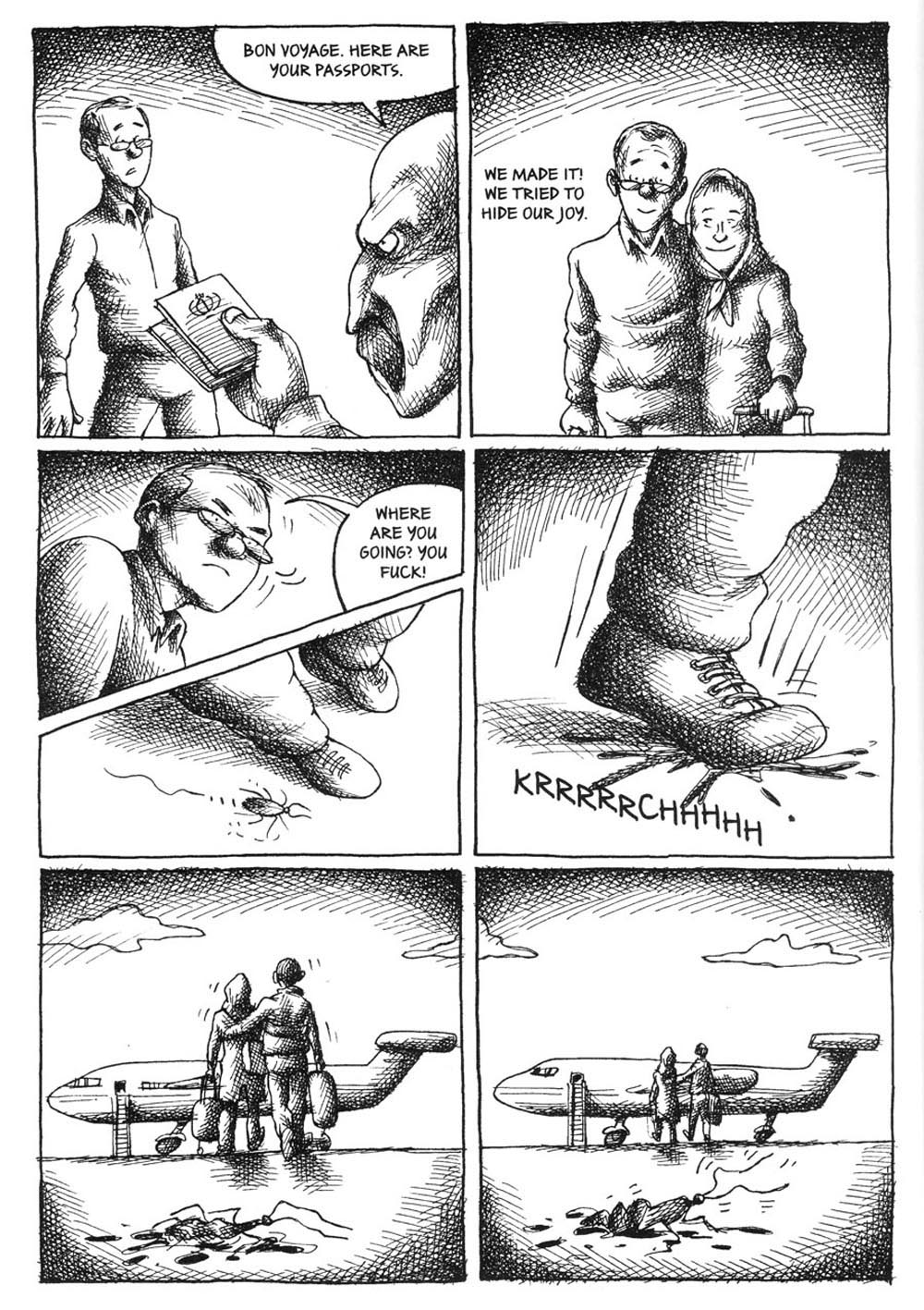 For lack of real content in this all-too-brief expose on Azeri life in Iran, I appealed to an Azeri friend and the Internet for more. My friend describes the cultural identity of the Iranian Azeris as something like the Southern states are to the US, or Staten Island is to New York. They have a particular accent that is “lovingly” mocked. Azeris are not considered to be unintelligent, but are distinctively “other.” An ethnic minority.
For lack of real content in this all-too-brief expose on Azeri life in Iran, I appealed to an Azeri friend and the Internet for more. My friend describes the cultural identity of the Iranian Azeris as something like the Southern states are to the US, or Staten Island is to New York. They have a particular accent that is “lovingly” mocked. Azeris are not considered to be unintelligent, but are distinctively “other.” An ethnic minority.
Through Wikipedia, I learned that Azerbaijanis in Iran are “a well integrated linguistic minority.” Despite friction, Azerbaijanis in Iran came to be well represented at all levels of “political, military, and intellectual hierarchies, as well as the religious hierarchy.” But all the references cited in this excerpt date from 1988 or earlier. Even after re-reading the book it seems that Neyestani is insensitive to Azeri concerns, and as a Western reader, I just don’t have enough information to know whether this is true. Unfortunately, the book doesn’t offer enough to see it another way.
***
The Cockroach
In the book, the editor-in-chief of the Iran says the Azeris were offended “because they mistakenly think they have been called cockroaches.” But how are they mistaken?
Cartoonist and advocate for comic literacy, Art Spiegelman, says in a recent interview on Democracy Now!, “Cartoons use symbolic language. If you don’t understand this you won’t understand cartoons.” Scott McCloud, cartoonist and comics theorist, talks about symbols in his seminal book Understanding Comics as being “images we use to represent concepts, ideas and philosophies.” According to this, the Azeris’ interpretation of the cartoon was spot on. They were symbolically called cockroaches, and because they understood the negative meaning of this symbol, they protested.
The symbolism of the cockroach is what drives the entire story. It is a nuisance, a pest. Something to be crushed. Political opponents are referred to as “cockroaches” in variations of the Spanish folk song “La Cucaracha.” During the Rwandan Genocide, Hutus referred to the Tutsi as cockroaches as they slaughtered a million of them. The obnoxious friend on The Cosby Show was nicknamed “Cockroach” because he just wouldn’t go away. To equate someone or a group of people with a cockroach has negative implications and that’s pretty universal, worldwide.
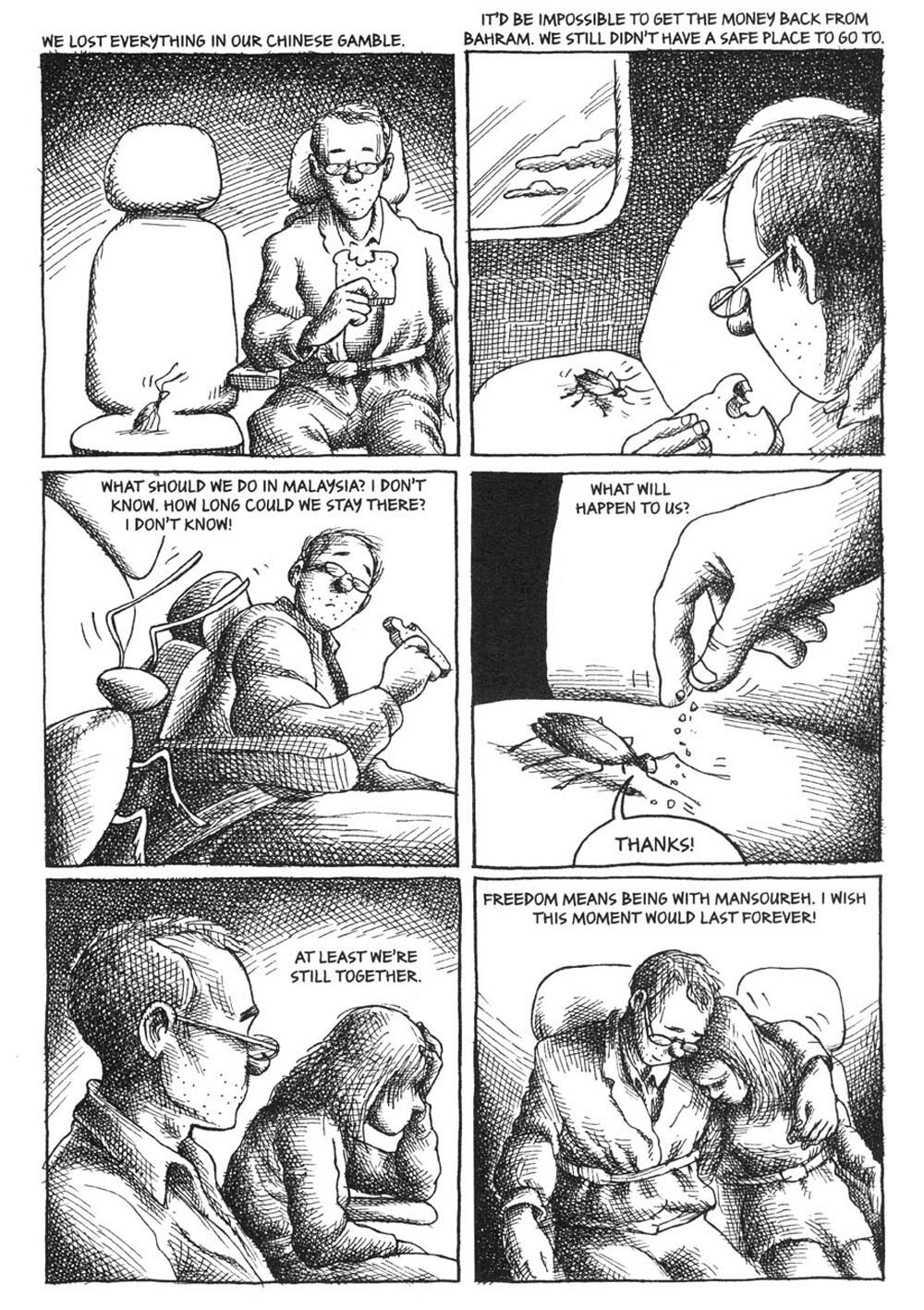 But throughout An Iranian Metamorphosis, Neyestani sticks to his guns. He maintains that he never called the Azeris cockroaches. He also never allows the possibility that the Azeris reacted understandably, or that even though it was unintentional, he was negligent in his crafting of symbolism. He holds tightly to the story that he is the victim of a big misunderstanding.
But throughout An Iranian Metamorphosis, Neyestani sticks to his guns. He maintains that he never called the Azeris cockroaches. He also never allows the possibility that the Azeris reacted understandably, or that even though it was unintentional, he was negligent in his crafting of symbolism. He holds tightly to the story that he is the victim of a big misunderstanding.
It is more than off-putting that Neyestani appropriates the symbol of the cockroach throughout the book, not as the insult felt by the Azeri people, but to represent his personal menace—one that torments him. A cockroach appears in his prison cell, in nightmares, in a dreary Dubai hotel, and finally on the airplane ride that transports he and his wife to freedom. In this final scene, he makes peace with the cockroach by offering it some breadcrumbs from his sandwich. That’s basically the same proportion of his story he offered to the Azeris. Ending the book on that note is cringeworthy.
***
The Verdict
Although the drawing and arrangement of the graphic elements in the book are gorgeous and make it a very enjoyable read, An Iranian Metamorphosis ultimately feels incomplete. Neyestani’s storytelling falls short as it accounts for only his experience within a much larger political landscape. Because he is a political cartoonist, I don’t think it is unfair for a reader to expect Neyestani’s story to be engaged with a greater political discourse. I can’t help but take note of the journalistic elements missing from the book.
While he maintains that he never intended to insult the Azeri people with his cartoon, the reality is that they were clearly insulted. In this sense, the book reads like a comedian explaining why his joke is funny when no one is laughing. It’s true that his intension counts, but it’s only part of the story. 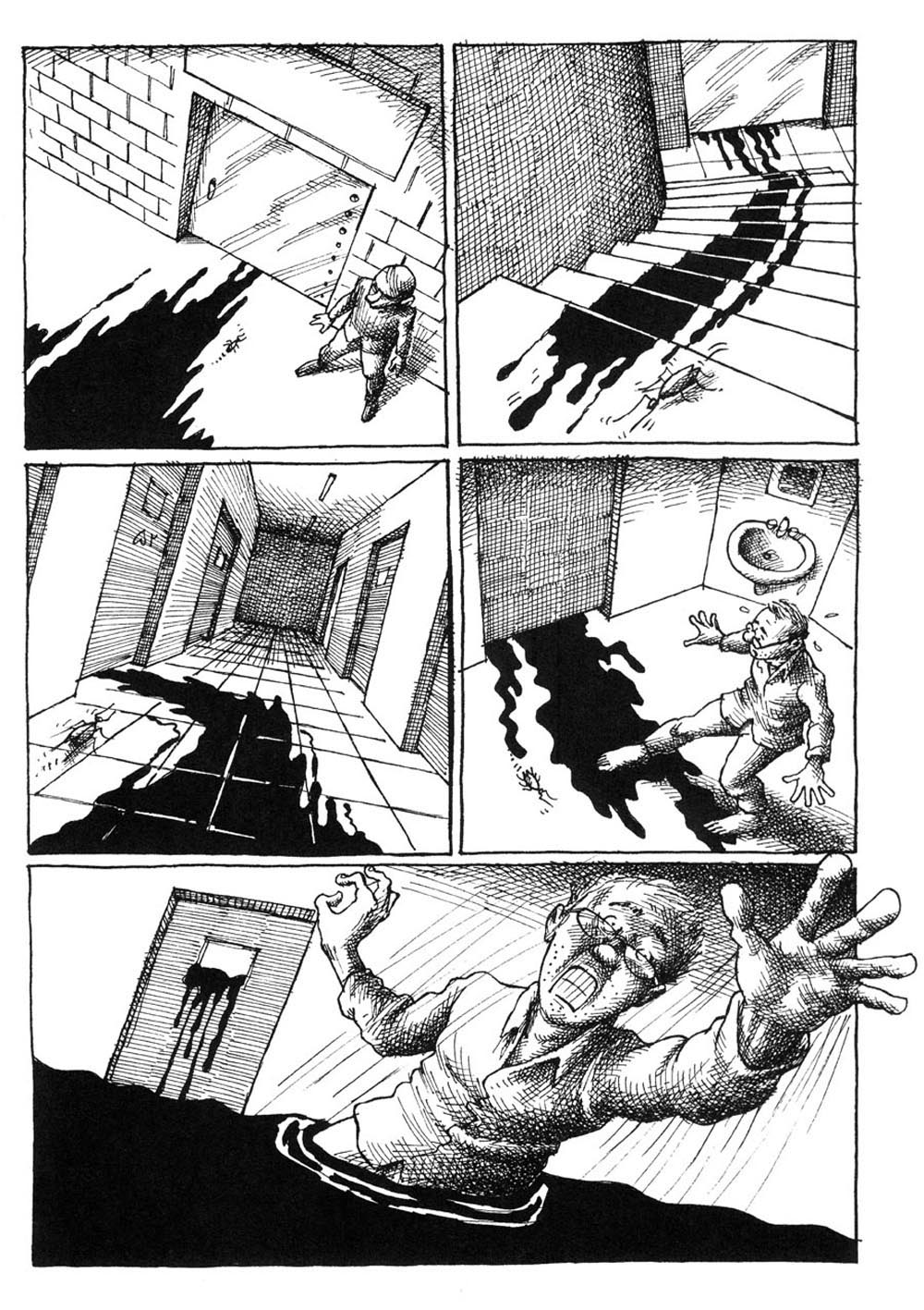 The other part—the missing part—is about how the cartoon was received and why it was received in that particular way. And this is where he leaves the reader stranded.
The other part—the missing part—is about how the cartoon was received and why it was received in that particular way. And this is where he leaves the reader stranded.
Granted, it’s difficult to tell a personal story that also contains highly political content. Few graphic novels strike a successful balance between the personal and political. Some solid examples are Maus, Citizen 13360 and, most recently, Fatherland by Nina Bunjevac. In all of the these, the autobiographical story serves as a portal into a larger, more complicated political landscape. As readers, we hold the hand of the narrator’s personal story—it’s the thing we can relate to and, therefore, trust—and it guides us through circumstances different than our own. It’s how we learn to empathize, and that’s a powerful thing. The strength of Neyestani’s book is in its ability to make the reader want to hold his hand, but when we arrive at the point where a new and unfamiliar world opens up all there is is the personal story. That’s just not enough.
As to the question of who is in charge of the cartoon’s meaning, I think the answer lies within the conversation about freedom of expression, something nearly non-existent in Iran. Freedom of expression is a conversation in itself. Meaning, I firmly believe that Neyestani should have the right to create cartoons and to write graphic novels that reflect his perspective. I also believe just as firmly that the public should have the right to respond to the cartoon, and thereby contribute to shaping its meaning and our cultural understanding of it. Artistic intention and public perception are part of a balancing act. Both sides inform how we ascribe meaning to images. Being “overly sensitive” is a counter accusation often used by those who have been challenged on the meaning of their work, and would rather create what they want without further discussion. In my opinion, participating in this discussion is not only the price of the freedom to create what you want, but it’s the right thing to do. There, I said it. I look forward to the impending objections.




